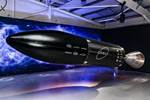Virgin Orbit LauncherOne rocket reaches space
Air-launched, liquid-fueled rocket makes historical debut with successfully targeted orbit and 10 NASA NSP payloads deployed.

Virgin Orbit’s customized 747-400 carrier aircraft, Cosmic Girl. Photo Credit: Virgin Orbit
Satellite launch company Virgin Orbit’s (Long Beach, Calif., U.S.) LauncherOne rocket — retaining filament wound composite propellant tanks — successfully reached space for the first time on Jan. 17, deploying 10 payloads for NASA’s Launch Services Program (LSP). According to Virgin Orbit this flight also marks a historical first: No other orbital class, air-launched, liquid-fueled rocket, it says, has successfully reached space until now.
Virgin Orbit’s novel launch system uses a technique called air launch, in which a rocket is launched from under the wing of a jet aircraft, rather than from a traditional launch pad on the ground. In addition to improving the payload capacity of the rocket, this technique enables the LauncherOne system to be what Virgin Orbit claims is the world’s most flexible and responsive launch service — flying on short notice and from a wide variety of locations to access any orbit.
Virgin Orbit’s carrier aircraft, a customized 747-400 dubbed Cosmic Girl, took off from Mojave Air and Space Port at approximately 10:50 a.m. and flew out to a launch site over the Pacific Ocean, about 50 miles south of the Channel Islands. After a smooth release from the aircraft, the two-stage rocket ignited and powered itself to orbit. At the conclusion of the flight, the LauncherOne rocket deployed 10 CubeSats — a type of miniaturized satellite for space research — into the team’s target orbit.
The payloads onboard LauncherOne were selected by NASA LSP as part of the agency’s CubeSat Launch Initiative (CSLI). Nearly all of the CubeSat missions were designed, built and tested by universities across the U.S., including Brigham Young University (PICS), the University of Michigan (MiTEE) and the University of Louisiana at Lafayette (CAPE-3).

Photo Credit: Virgin Orbit
“A new gateway to space has just sprung open! That LauncherOne was able to successfully reach orbit is a testament to this team’s talent, precision, drive and ingenuity. Even in the face of a global pandemic, we’ve maintained a laser focus on fully demonstrating every element of this revolutionary launch system. That effort paid off today with a beautifully executed mission, and we couldn’t be happier,” says Virgin Orbit CEO Dan Hart.
With this successful demonstration in the books, Virgin Orbit says it will officially transition into commercial service for its next mission. Virgin Orbit has subsequent launches booked by customers ranging from the U.S. Space Force and the U.K.’s Royal Air Force to commercial customers like Swarm Technologies, Italy’s SITAEL and Denmark’s GomSpace.
The company’s next few rockets are already well into integration at its Long Beach, Calif., U.S., manufacturing facility.
“Virgin Orbit has achieved something many thought impossible. It was so inspiring to see our specially-adapted Virgin Atlantic 747, Cosmic Girl, send the LauncherOne rocket soaring into orbit. This magnificent flight is the culmination of many years of hard work and will also unleash a whole new generation of innovators on the path to orbit. I can’t wait to see the incredible missions Dan and the team will launch to change the world for good,” adds Virgin Group founder Sir Richard Branson.
Related Content
New GTL breakthrough in composite tubing for liquid hydrogen in aircraft and space vehicles
Tests versus stainless steel tubing show 10 times faster chill down, fuel flow in 2 seconds and less boil-off for significantly faster fueling and refueling of LH2-powered space vehicles, aircraft and trucks.
Read MoreHyImpulse, Adamant Composites linerless CFRP tank passes hydrostatic burst test
The liquid oxygen (LOX) tank, to be used in a HyImpulse smallsat launch vehicle, demonstrates the ability to withstand pressures well beyond the limits of its intended use.
Read MoreOn the radar: Cryogenic testing of composites for future hydrogen storage
Netherlands, U.K., France, Germany and the U.S. build up test capability, look at thermoset and thermoplastic composite materials.
Read MoreNanomaterials optimize performance of space-ready carbon fiber composite panels
A recent ESA project led by Adamant Composites aimed to mature nanomaterial-enhanced CFRP for lighter weight, more thermally and electrically conductive materials for manufacturing satellite structures.
Read MoreRead Next
Composites design helps nano-sized lunar rover hit big milestones
Developed by Carnegie Mellon University, the ultralight, composites-intensive Iris nano-rover will make its lunar debut later this year.
Read MoreAnomalies force Virgin Orbit to terminate LauncherOne test
Despite the termination, the test flight provided data necessary to make adjustments for future launches.
Read MoreOrbex secures $24 million funding round for U.K. space launch
New funding secures roadmap to first launch of composites-intensive Orbex Prime rocket from Sutherland spaceport in Scotland.
Read More
























